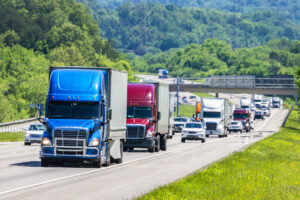
[From the last episode: We looked at what it takes to generate data that can be used to train machine-learning systems.]
We take a break from learning how IoTThe Internet of Things. A broad term covering many different applications where "things" are interconnected through the internet. technology works for one of our occasional posts on how IoT technology is used. In this case, we look at trucking fleet management.
What’s Yer 20?
A company called Convoy announced the ability to manage fleets of semi-trailers that are heavily instrumented with sensorsA device that can measure something about its environment. Examples are movement, light, color, moisture, pressure, and many more. for lots of different purposes. You know how we like to be able to track those packages we’ve purchased online to see where they are and when they’ll arrive? Well, that’s popular for industrial users too, not just us consumers. That’s what this is for.
The sensors on these trailers allow their customers to see:
- What it contains
- When the truck was loaded
- Where it’s headed
- Travel speed
- How the internal temperature is maintained (like for frozen cargo)
- If anything has been damaged
- If anything has been stolen
- Whether it’s attached (tethered) to another truck
- When it’s supposed to arrive.
Of course, the sensors don’t provide this data directly. The data that they provide is analyzed, and this information is constructed from that analysis. The trailers must provide a regular stream of data to a data centerA collection of computers that are interconnected so that they can share and distribute work. For our purposes, it’s the same as a computer farm, but the focus is on its application for processing data., where the high-level calculations are derived from the low-level data.
How Does That Help Me?
Quoting directly from their press release, there are a number of scenarios that this helps with:
- “Load analysis – Can measure cargo status, which is suitable for LTL [less-than-a-truckload] scenarios, fleet leasing, and enhanced delivery management analysis
- Theft detection – Instant alerts greatly increases the chances that theft can be detected and prevented or recovered.
- Cold chain compliance – Regular temperature measurements that exceed regulatory standardsA way of doing something specific that has been agreed by multiple parties in an official manner. Some "standards" aren't official standards; the best ones have been established in an open fashion, where anyone with an interest can contribute and where large companies can't push little companies around..
- Yard management – Instant alerts on movement provide real-time information about the fleet location to support accurate yard management.
- Maintenance – More accurately tracking miles driven can help more effectively manage trailer maintenance schedules.
- Geo-fence control – Controlling based on location (e.g. using geo-fences) allowing users to “tune” the fleet to meet the unique needs of their business and processes.
- Deep data analysis – Multiple years of data can be used to analyze trailer, fleet, and corporate performance over time and geography.”
This does have the downside of being a “surveillance” technology, where, as a driver, you know that someone’s watching your every move. While I’m generally not a fan of over-surveillance, this does deal with a situation where drivers are in control of someone else’s goods, and it helps to know what’s happening with them. It doesn’t have to be punitive (although it could be if there were abuses – or, said another way, it could deter abuses). Many of the uses are informational, or add to efficiency, or help to prove, for instance, that frozen foods never warmed up before being refrozen.
So you can add “smart trailers” to the list of “smart” things in our midst.

Leave a Reply